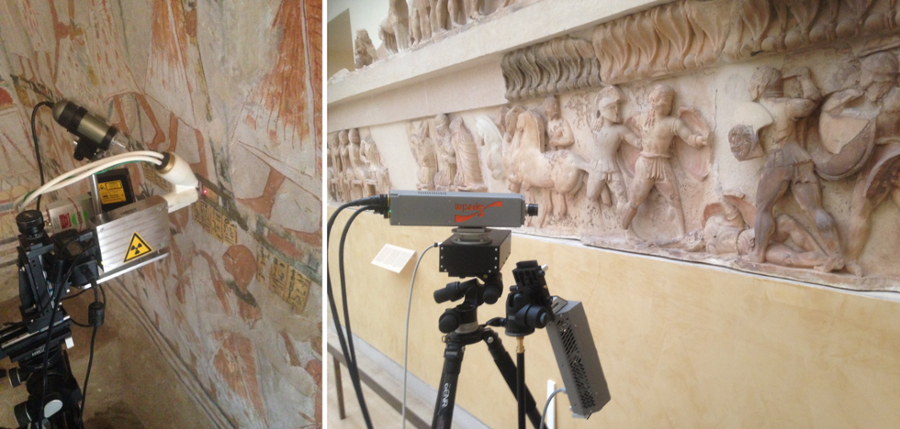Summer 2019 Speaker Series: Matthias Alfeld from Delft University of Technology, Netherlands on August 14th | "Evaluating Spectroscopic Imaging Data of Cultural Heritage Objects Acquired on the Macroscopic Scale"
The Center's Science for Art Spring 2019 Speaker Series welcomes Matthias Alfeld from Delft University of Technology, Netherlands on August 14th to give a talk on "Evaluating Spectroscopic Imaging Data of Cultural Heritage Objects Acquired on the Macroscopic Scale. " He will discuss how macroscopic and microscopic scale investigations of cultural heritage objects, and the novel approaches to exploit local information beyond the isolated pixel level, can obtain more meaningful representations and discuss their practicality.
Matthias Alfeld is an Assistant Professor at the TU Delft (NL) for "X-rays in Art and Archaeology", working on the investigation of cultural heritage objects, the development of new data evaluation workflows and contributing to the Smart*Light project, a novel Inverse Compton X-ray source.
Talk Details:
Wednesday, August 14th, 12:30-1:30pm
Technological Institute – Tech L251
2145 Sheridan Road
Evanston, IL, 60208
Full Abstract:
Evaluating Spectroscopic Imaging Data of Cultural Heritage Objects acquired on the Macroscopic Scale
Matthias Alfeld
From the perspective of a scientist, cultural heritage objects are among the most challenging to be investigated. Investigations need to be minimal to non-invasive, limiting sampling to an absolute minimum, if permitted at all. The heterogeneous nature of these objects on a macroscopic and microscopic scale complicates investigations further and limits the possibility to draw general conclusions from samples.
This challenge has motivated the development of a large number of dedicated instruments for the investigation of cultural heritage objects, many of them employing spectroscopic imaging to address the heterogenity. Modern instruments allow for a rapid acquisition of data, shifting the bottleneck from data acquisition to data evaluation. Especially if measurements are done on site or with instruments that are available only for a limited time period (like synchrotron beamlines), it is crucial to evaluate the data rapidly with a minimum amount of user intervention to verify their quality and take the results into account when planning the next experiments.
The data evaluation translates the high dimensional hyperspectral data into a compressed, legible representation. This is commonly done by model driven evaluation (such as fitting of XRF spectra) or data driven evaluation (such as clustering of reflectance imaging spectra by endmembers). Treating during this investigation each pixel/spectrum and each data set individually allows to gain meaningful representations, but is wasting potential synergy in the data.
Another challenge is the practical application of data evaluation approaches. In the last years many innovative solutions have been described in literature that improve different aspects of data evaluation. But scripts and command line based operations will find only limited application in museum workshops and at archaeological excavations.
The talk will address novel approaches to exploit local information beyond the isolated pixel level to obtain more meaningful representations and discuss their practicality. Further, approaches to establish new data evaluation protocols in the field will be discussed.
About Matthias Alfeld:
After his studies in Chemistry at the University of Hamburg (DE), Matthias Alfeld did his PhD thesis at the Universities of Hamburg and Antwerp (BE) from 2008-2013. Topic of his thesis was the development of scanning macro-XRF for the investigation of historical paintings, involving the design of instruments, their application and development of data evaluation workflows.
From 2013-2015 he worked as a PostDoc at the German Electron Accelerator DESY (Deutsches Elektronen Synchrotron) in Hamburg at the hard X-ray micro-probe beamline P06. During this time he supported users in the investigation of microscopic samples with X-rays and explored the use of matrix factorization for spectroscopic imaging.
From 2015 to 2018 he was Junior Chair at the Laboratory for Molecular and Structural Archaeology (Laboratoire d’Archéologie Moléculaire et Structurale (LAMS)) at the Sorbonne University in Paris (FR). He used X-rays and reflectance imaging spectroscopy to study remnants of paint on archaeological objects from Antiquity and Ancient Egypt and developed data evaluation routines for these challenging data sets.
After an intermediate stay at DESY, filling in his old position, he is an Assistant Professor at the TU Delft (NL) for "X-rays in Art and Archaeology" since November 2018, working on the investigation of cultural heritage objects, the development of new data evaluation workflows and contributing to the Smart*Light project, a novel Inverse Compton X-ray source.
